

Sanjhi is a festival to the namesake goddess, mainly by women and girls in parts of Delhi, Punjab, Haryana, and Uttar Pradesh. [1]


Sanjhi is a festival to the namesake goddess, mainly by women and girls in parts of Delhi, Punjab, Haryana, and Uttar Pradesh. [1]
Sanjhi is the name of a mother goddess, after whom images are made of mud and molded into various shapes such as cosmic bodies or the face of the goddess, and they get different colors. The local potters make images of various body parts like her arms, legs, face decked with ornaments and weapons. These additions make the image look beautiful and gracious. The additions to the image this way depend upon the economic means of the family. [2]
The image is designed on the first day of the nine days of Durga Puja or Navratri. Every day women from the neighborhood are invited for singing bhajans and performing aarti. The young girls also gather there and offer their adoration to the mother who is believed to get them suitable husbands. The aarti or the bhajans are chanted daily and some elderly woman guides others. Men can also be a part of the puja after work of the day gets over. Sanjhi image is prepared on the wall by those families who seek fulfillment of their wishes termed mannat by Punjabis. Some people also seek her blessings for the marriage of their daughters. Kirtan is performed and the image is immersed in water on the last day. The Sanjhi festival ends with the immersion of Sanjhi on the day of Dussehra. [3]
The girls offer prayers and food to the goddess every day.
As a traditional art of Vraja, Lord Krishna’s homeland, sanjhi is intrinsically linked to the transcendental sports of the divine couple Krishna and Radha, whose play of love is depicted in the sanjhi designs. Vaishnava theology traces the origin of sanjhi to the divine lila itself: sanjhi designs were created by Radha in order to evoke Lord Krishna’s presence. Folk mythology also holds another version of the same lila, according to which it was Lord Krishna who, at evening twilight time, prepared a beautiful image of Radha made of flowers in order to appease her. [4]
The early tradition of preparing sanjhis made of cow dung and flowers, which is still practiced in the villages, has been taken up by the Vaishnava temples around the 15th/16th centuries and developed into a highly sophisticated art form practiced by specially trained Brahman priests. [5] The major type of temple sanjhi is prepared from dry colors upon an octagonal earthen platform symbolizing an eight-petalled lotus. The heart (hauda) of the design constitutes the seat of the divine couple, the sanctum sanctorum; from here, an intricate layout of artfully interlocked diagonal patterns enables the expansion of divinity towards the eight directions. The worship of a mystic design as in sanjhi is rooted in early Hinduism and Tantrism, and has obvious parallels in Vajrayana and Mahayana Buddhism. In both cases, song rendered in front of the design constitutes the central element of worship. [4]
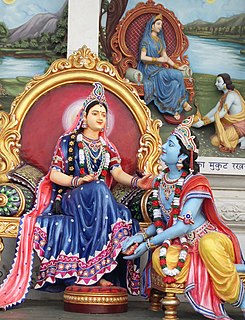
Radha, also called Radhika, is a Hindu goddess and a consort of the god Krishna. She is worshiped as the goddess of love, tenderness, compassion and devotion. She is the avatar of Lakshmi and is also described as the chief of gopis (milkmaids). During Krishna's youth, she appears as his lover and companion, though he is not married to her. In contrast, some traditions and scriptures accord Radha the status of the eternal consort and wife of Krishna. Radha, as a supreme goddess, is considered as the female counterpart and the internal potency of Krishna, who resides in Goloka, the celestial abode of Radha Krishna. Radha is said to accompany Krishna in all his incarnations.
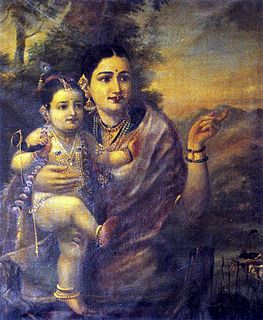
Krishna Janmashtami, also known simply as Janmashtami or Gokulashtami, is an annual Hindu festival that celebrates the birth of Krishna, the eighth avatar of Vishnu. It is observed according to the Hindu lunisolar calendar, on the eighth day (Ashtami) of the Krishna Paksha in Bhadrapada, which overlaps with August or September of the Gregorian calendar.
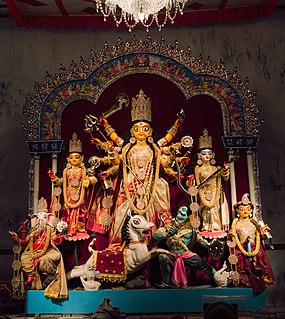
Durga Puja, also known as Durgotsava, or Sharodotsava, is an annual Hindu festival originating in the Indian subcontinent which reveres and pays homage to the Hindu goddess and is also celebrated because of the victory of goddess durga over mahishasur, Durga. It is particularly popular and traditionally celebrated in the Indian states of West Bengal, Jharkhand, Assam, Odisha, Tripura, Mithilanchal region of Bihar and the country of Bangladesh. The festival is observed in the Indian calendar month of Ashwin, which corresponds to September–October in the Gregorian calendar, and is a ten-day festival, of which the last five are of significance. The puja is performed in homes and in public, the latter featuring a temporary stage and structural decorations. The festival is also marked by scripture recitations, performance arts, revelry, gift-giving, family visits, feasting, and public processions. Durga puja is an important festival in the Shaktism tradition of Hinduism.

Mathura district situated along the banks of the river Yamuna is a district of Uttar Pradesh state of north-central India. The historic city of Mathura is the district headquarters. It also is famous for the city of Vrindavan, one of the most sacred places in Vaishnavism. The District is part of Agra division. Total area of Mathura district is 3340 sq. km.

Sharad Purnima is a harvest festival celebrated on the full moon day of the Hindu lunar month of Ashvin, marking the end of the monsoon season. On this auspicious day, many divine pairs like Radha Krishna, Shiva Parvati, and Lakshmi Narayan are worshipped along with the moon and are offered flowers and kheer. Deities in temples are usually dressed in white color signifying the brightness of moon. Many people observe full day fasting on this day.
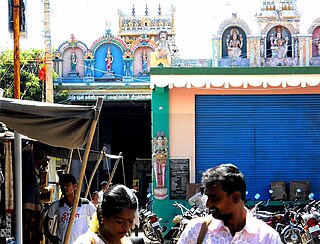
Devi Kanya Kumari is the manifestation of Parvati in the form of an adolescent girl child. Devi is also known as Shrī Bāla Bhadra or Shrī Bāla. She is popularly known as "Shakti" "Devi". The Bhagavathi Kumari Amman Temple is located in Kanyakumari in Tamil Nadu, at the southern tip of main land India, there by located on the confluence of the Bay of Bengal, the Arabian Sea, and the Indian Ocean. She is also known by several other names, including Kanya Devi and Devi Kumari. She is also worshiped as an incarnation of the goddess Bhadrakali by her devotees. Sage Parashurama is said to have performed the consecration of the temple. The goddess is believed to be the one who removes rigidity of the mind; devotees usually feel the tears in their eyes or even inside their mind when they pray to the goddess in devotion and contemplation.

Teej is the generic name for a number of Hindu festivals that are celebrated by women. Haryali Teej and Hartalika Teej welcome the monsoon season and are celebrated primarily by girls and women, with songs, dancing and prayer rituals. The monsoon festivals of Teej are primarily dedicated to Parvati and her union with Shiva. Women often fast in celebration of Teej. Hartalika Teej is celebrated in all parts of Nepal and most of the parts of North India .Teej festivals are traditionally observed by women to celebrate the monsoons during the months of Shravan and Bhadrapada in the Hindu calendar. Women often pray to Parvati and Shiva during Teej.
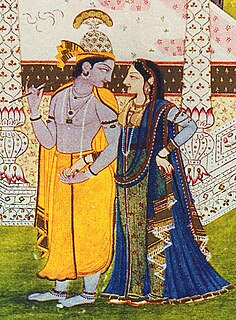
Radha-Krishna are collectively known within Hinduism as the combined forms of feminine as well as the masculine realities of God. Radha and Krishna are the primeval forms of God and his pleasure potency respectively in several Vaishnavite school of thought.
This article lists the traditional festivals and other cultural events in the Odisha region of India. Odisha celebrates 13 festivals in 12 months as the saying goes "BAARA MASARE TERATA PARBA"
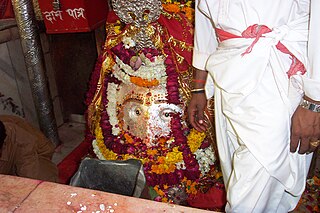
Kalkaji Mandir, also known as Kalkaji Temple, is a Hindu mandir or temple, dedicated to the Hindu Goddess Kali. The temple (mandir) is situated in the southern part of New Delhi, in Kalkaji, India, a locality that has derived its name from the temple and is located opposite the Nehru Place business centre and close to the Okhla railway station, Kalkaji Mandir metro station. Hindus believe that the image of the Goddess Kalka here is a self-manifested one.

Manipuri Vaishnavism is a regional variant of Gaudiya Vaishnavism with a culture-forming role in the north-eastern Indian state of Manipur. Most Vaishnavires of Manipur belong to Narottama Dasa Thakura's lineage (parampara).

Gundicha Temple, is a Hindu temple, situated in the temple town of Puri in the state of Odisha, India. It is significant for being the destination of the celebrated annual Rath Yatra of Puri. While it remains vacant most of the year, the temple is occupied by images of the deities of Jagannath, his brother Balabhadra and sister Subhadra for seven complete days every year during the annual Rath Yatra festival.

Chhatarpur Temple is located in a down town area in south of Delhi - Chhatarpur, India. This temple is dedicated to Goddess, Katyayani. The entire complex of the temple is spread over a wide area of 70 acres. It is located at Chhatarpur, on the southwestern outskirts of the city of Delhi and is just 4 km (2.5 mi) from Qutub Minar, off Mehrauli-Gurgaon road.

Kali Puja, also known as Shyama Puja or Mahanisha Puja, is a festival, originating from the Indian subcontinent, dedicated to the Hindu goddess Kali, celebrated on the new moon day of the Hindu month Kartik especially in the regions of Bengal, and in Mithila, Odisha, Assam and the town of Titwala in Maharashtra. Kali Puja is extremely popular in Tamluk, Barasat and Naihati. It coincides with the Lakshmi Puja day of Diwali. While the Hindu Bengalis, Odias, Assamese and Maithils worship the goddess Kali on this day, the rest of India and Nepal worships goddess Lakshmi on Diwali.
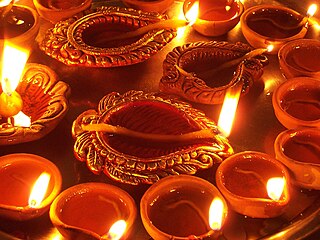
Worship in Hinduism is an act of religious devotion usually directed to one or more Hindu deities. A sense of Bhakti or devotional love is generally invoked. This term is probably a central one in Hinduism, but a direct translation from the Sanskrit to English is difficult. Worship takes a multitude of forms depending on geography and language. Worship is not confined to any place of worship, and it will often incorporate personal reflection, music, dance and poetry. Hindus usually perform worship in temples or at home to achieve some specific end or to integrate the body, mind and spirit. The aim is to live a pure life in order to help the performer reincarnate into a higher being.
Punjabi festivals are various festive celebrations observed by Punjabis in Pakistan, India and the diaspora Punjabi community found worldwide. The Punjabis are a diverse group of people from different religious background that affects the festivals they observe. According to a 2007 estimate, the total population of Punjabi Muslims is about 90 million, with 97% of Punjabis who live in Pakistan following Islam, in contrast to the remaining 30 million Punjabi Sikhs and Punjabi Hindus who predominantly live in India.
Here is a list of glossary of Culture of India in alphabetical order:
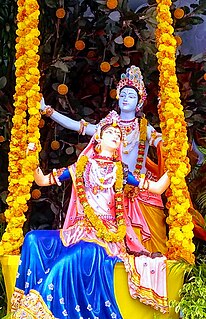
Jhulan Yatra is one of the most important festivals for the followers of Lord Krishna celebrated in the monsoon month of Shravan. According to Gregorian calendar, this festival falls in the period of July-August. After Holi and Janmashtami, it is the biggest and most popular religious occasion of the Vaishnavas. Known for its spectacular display of decorated swings, song and dance, Jhulan is a joyful festival celebrating the Radha Krishna amour coupled with the romantic fervor of the rainy season in India.

Hinduism is one of the religions practiced in the state of Manipur, India. Hinduism is concentrated in the valley districts of Manipur located in the regions neighbouring Assam state. Hinduism is practiced mostly among the Meitei people, Nepali people, and Bengali people. Whilst the proportion of Manipur's population that practices Hinduism is roughly 41%, in the Manipur valley region Hindus constitute as much as 67-74% of the population.